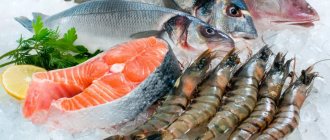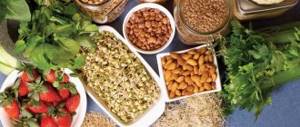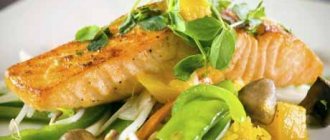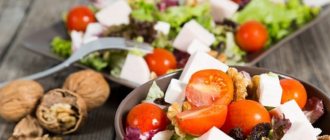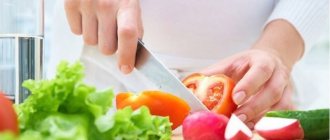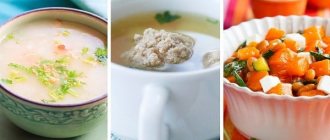Useful menu
It is best to consult a doctor so that a specialist can prescribe a diet, since treatment at home can be harmful.
Sample menu for the week:
- On Monday, you can prepare oatmeal with honey for breakfast. Complete the menu with bread and green tea. After a few hours, have a snack with cottage cheese and fruit. At 12:00 prepare borscht without meat, boil potatoes or fish. It is recommended to drink fruit compote. Afternoon snack - berries. We have dinner with boiled meat and vegetables.
- Tuesday. For breakfast we eat buckwheat with a boiled egg and drink it with a herbal drink. Snack: dried fruits. For lunch - zucchini soup, lean boiled meat and green tea. Afternoon snack - fruit. Dinner - vegetable casserole, bread, kefir.
- Wednesday. For breakfast we eat pumpkin porridge with a spoonful of jam. You can drink it with herbal infusion. For second breakfast - a few marshmallows and green tea. Lunch - buckwheat soup, boiled chicken meat and vegetable salad, compote. Afternoon snack - cottage cheese and fruit. Dinner - vegetable salad with chicken and pineapple. You need to wash it down with a drink made from chicory.
- On Thursday, the menu for chronic glomerulonephritis is as follows - for breakfast we eat rice porridge, boiled egg, compote. Second breakfast - green tea with marmalade. Lunch - millet soup, boiled rabbit, bread. Afternoon snack - berries, dinner - cottage cheese, fruit and compote.
- Friday. For breakfast we eat boiled chicken, beet salad, and weak tea. Second breakfast - ice cream and natural juice. Lunch - buckwheat soup, boiled turkey meat, bread. Afternoon snack - kefir. Dinner - baked fish, vegetable salad and compote.
- Saturday. For breakfast we prepare a vegetable casserole, bread, and kefir. Second breakfast - low-fat ice cream, apple. Lunch - buckwheat soup, baked fish, unsalted bread. Afternoon snack - dried fruits. Dinner - pilaf with the addition of prunes and dried apricots, rosehip decoction.
- Sunday. Breakfast - boiled veal meat, vegetable salad and bread, weak tea. Second breakfast - a glass of compote with cookies. Lunch - milk rice soup, mashed potatoes and boiled fish. Afternoon snack - fruit salad. Dinner - vegetable salad, bread and kefir.
Sample menu
The menu is drawn up after the tests and must take into account all the characteristics of the patient’s body and his taste preferences. Let's consider a sample menu for glomerulonephritis:
- for breakfast you can cook steamed vegetable cutlets and drink a cup of weak tea;
- for the second breakfast, eat permitted fruits;
- for lunch you should eat vegetable soup, stewed lean meat, baked potatoes and fruit juice;
- in the afternoon you can drink a glass of rosehip decoction;
- for dinner, eat cereal cooked in water and a vegetable salad with the addition of vegetable oil, drink a cup of herbal tea;
- An hour before bedtime, it is recommended to drink a glass of freshly squeezed juice or kefir.
Return to contents
Diet menu for glomerulonephritis
You can create a menu yourself, based on the list of prohibited and permitted products. Below we will present two options for approximately a daily diet.
- Option 1. The first breakfast can consist of carrot and apple cutlets. Naturally, they must be baked in vegetable oil. You can eat sago milk porridge and drink tea. For second breakfast - fresh fruit. Lunch: vegetarian soup, boiled meat with tomato sauce, potatoes and jelly. For an afternoon snack, a decoction of wheat bran. Dinner may consist of pilaf with fruit and vegetable salad. You can season it with vegetable oil and wash it all down with weak tea. It is perfectly acceptable to drink a glass of fruit juice at night.
- Option 2. First breakfast - cabbage salad, a small pudding consisting of rice and apples, tea. For second breakfast – carrots and grated apples. Lunch: vegetarian vegetable soup, boiled meat and potatoes, and dried fruit compote. Fresh cheese with sour cream is perfect for dinner. You can eat a hard-boiled egg, as well as tea with milk. Drink a glass of jelly at night. For the whole day you can eat no more than 300 grams of bread, 30 grams of sugar and 15 grams of butter.
What is possible, what is not
| Products | Beverages | |
| It is forbidden |
| Do not consume any drinks containing alcohol, avoid drinking:
|
| Can |
|
|
What to limit
For glomerulonephritis, exclude the following foods from the diet:
- baked goods with added salt;
- meat and fish broths;
- legume products;
- canned food;
- products made from puff pastry and butter dough;
- caviar;
- cheeses;
- smoked meats;
- mushrooms, mushroom broths;
- garlic;
- sorrel and spinach;
- raw onion;
- radish;
- salted vegetables;
- pickled products;
- cocoa;
- ice cream;
- chocolate;
- alcohol;
- sparkling waters.
While following diet No. 7A, it is forbidden to eat meat and fish, cottage cheese, desserts made from milk, and cauliflower.
Is a diet necessary at all?
As a rule, for any disease of the internal organs, the doctor prescribes a diet or diet that must be followed, the stricter the better. Diets are often used for external lesions.
For glomerulonephritis, a diet is prescribed that primarily limits the use of:
- fat;
- canned;
- smoked;
- meat (if the meat is fatty);
- acute;
- containing alcohol.
These products can both provoke the disease and simply help it develop. If you ignore this recommendation, you can get several additional diseases as complications:
- renal failure;
- blurred vision;
- chronic form of glomerulonephritis;
- eclampsia.
Recommended for use:
- porridge;
- compotes;
- cereals;
- oils;
- lean types of meat;
- vegetables;
- juices;
- fruits.
More detailed product directions are described in the next section.
As for your diet, you should eat little and often, about five or six times a day. You need to drink at least one and a half liters of water per day.
Diet recipes for glomerulonephritis
There are many interesting recipes that can be used in everyday life. So, you can prepare a green salad. It is very simple to prepare, just take 2 fresh cucumbers, chop them finely and add dill and parsley. Season everything with vegetable oil.
- Vinaigrette with cauliflower. To prepare, take 2 potatoes, carrots, one beet, 5 cauliflower inflorescences and several lettuce leaves. Vegetable oil and dill are suitable as a dressing. Everything is thoroughly washed, boiled and cut into cubes. After which it is seasoned with dill and oil, then mixed. A tasty and healthy salad is ready.
- Cauliflower soup. To prepare, you need to take a head of cauliflower, one zucchini, a quarter glass of milk, a glass of vegetable broth, as well as a teaspoon of flour and butter. A boiled egg is suitable for decoration. The first step is to prepare the cabbage and pour boiling water over it. The zucchini is washed, peeled and cut into cubes. After which the vegetables are placed in a saucepan and simmered over low heat along with oil and a quarter glass of water. Meanwhile, add butter and flour to a frying pan. All ingredients are fried, then diluted with broth and boiled for 10 minutes.
- Summer borscht. You should take beets along with tops, new potatoes, zucchini, carrots and tomatoes, just one thing each. For taste, take butter, egg and sour cream. The beets, along with the tops and carrots, are fried in oil. Then you need to chop the tomato and stew it. Potatoes and zucchini, cut into cubes, are placed in boiling water and cooked until half cooked. Then beets are added here and brought to full readiness. The boiled egg is finely chopped and placed in the finished soup as a decoration.
- Chicken dumplings. To prepare this dish, you need to take 150 grams of chicken fillet, 50 grams of bread, half a glass of milk, a tablespoon of butter and an egg. The meat is passed through a meat grinder along with soaked bread. Then the egg and butter are added here. After which everything goes well. Next, the quenelles are formed and steamed.
[35], [36], [37], [38], [39]
Delicious recipes
Vegetable salad. To prepare it you will need to take several medium potatoes, one carrot and beetroot, a small onion, a little olive oil and optional herbs. Vegetables should be boiled, peeled and cut in any convenient way. Then cut the onion into small slices and add to the rest of the ingredients, season with olive oil. Serve the salad sprinkled with herbs.
Noodle soup is easy to digest.
Noodles soup. You need to prepare 3 potatoes, onions, noodles and several bay leaves. First, peel and cut the potatoes into small cubes. Then peel and chop the onion, add it to the pan along with the potatoes, add water and cook for about 20 minutes. Then add the noodles to the soup, bring to a boil and cook for another 10 minutes over low heat, then add the bay leaf. It is important to ensure that the noodles do not overcook.
Diet pancakes. You will need 1/3 cup of flour, half a glass of milk, 2 chicken eggs, a tablespoon of olive oil, a little sugar and salt. You need to add flour, sugar and salt to the container, then pour in milk. Next, beat the egg into the mixture and stir to obtain the consistency of sour cream. If necessary, you can add a little more flour or milk. Add olive oil to the dough and place a frying pan on the stove to heat up. Pancakes should be fried over medium heat without adding oil to the pan.
Summer borscht. To prepare, use 2 potatoes, 1 beet, carrot, zucchini, tomato, a little butter, an egg and a spoon of sour cream. Beets are fried in butter along with carrots. The tomato is cut into slices and stewed. Potatoes and zucchini are cut into cubes and placed in water, where they should be boiled until almost ready. Then add carrots and beets to the pan and cook until tender. The egg is boiled, then cut in a convenient way. Serve borscht with an egg and a spoonful of sour cream.
etopochki.ru
Seven-day menu for people with kidney disease
| meal | Monday | Tuesday | Wednesday | Thursday | Friday | Saturday | Sunday |
| 1 breakfast | oatmeal with milk, fruit salad, tea | grated vegetables, omelette, juice | cottage cheese casserole with raisins, mixture of plums and pears, compote | rice porridge, boiled vegetables, jelly | baked apple, cottage cheese, rosehip decoction | oatmeal with berries, yogurt | egg white omelette, beets with butter, tea |
| 2 breakfast | apple | watermelon | carrot salad | baked apple | melon | watermelon | apple |
| dinner | spring soup, steamed meatballs | Lenten borscht, chicken | potato soup, boiled fish | borscht without meat, beef stew | cabbage soup, baked breast with mashed potatoes | vegetable soup, steam cutlets | |
| afternoon tea | dried fruit infusion | rosehip drink | berry compote | apple drink | milk jelly | herbal decoction | curdled milk |
| 1 dinner | boiled potatoes and cauliflower | carrot cutlets, sour cream | Vegetable stew | cottage cheese casserole with dried apricots | rice porridge, stewed vegetables | baked rabbit, fermented baked milk | vegetable zrazy, herbal tea |
| 2 dinner | juice | kefir | juice | compote | juice | kefir | juice |
Diet price
The diet is not expensive, since there are restrictions on meat and fish. It is based on vegetable and cereal dishes, dairy - also limited. The cost of a weekly menu is 1300-1400 rubles.
NOTE! The information about diets on the site is for reference and general information, collected from publicly available sources and cannot serve as a basis for making a decision about their use. Before using the diet, be sure to consult a dietitian.
Source: medside.ru
What can you eat if you have glomerulonephritis?
In fact, dietary restrictions are not critical. It is quite possible to eat bread and flour products. These include salt-free bread, pancakes and pancakes prepared with yeast. Salt should be excluded everywhere. As for soups, preference should be given to vegetarian options. You can season them with herbs, but not with spices.
- Meat and poultry. Low-fat varieties of meat products are allowed; they need to be steamed. After boiling them, you can lightly fry them. Everything should be consumed in chopped form. Fish. You can eat low-fat fish; naturally, it should also be boiled. As for dairy products, it can be anything, but only in limited quantities.
- Cereals. You are allowed to eat any cereals, and even pasta. Among vegetables, potatoes are especially beneficial. It is important to steam it correctly. You can dilute the diet with salads, a vinaigrette will do. As for sweets, you should pay attention to berries and fruits, jam, and ice cream. Sauces and spices are used in limited quantities. As for drinks, you should pay attention to weak tea, coffee, and fruit juices.
Basic principles of nutrition
The diet for glomerulonephritis involves unquestioning adherence to the diet, which is compiled by a specialist. The diet is prescribed after the patient undergoes all the necessary examinations. It is important for a person to maintain a diet, since it reduces the load on the kidneys and normalizes the general condition of the body.
Return to contents
Authorized Products
Nutrition for glomerulonephritis should consist of:
- sour milk;
- as many vegetables and fruits as possible;
- lean fish and meat;
- croup;
- boiled eggs;
- freshly squeezed juices, fruit compotes and fruit drinks;
- vegetable oils.
Return to contents
Forbidden food
There are a number of foods that can adversely affect the course of the disease and lead to its aggravation, causing kidney failure. Patients are strictly advised not to consume the following during the glomerulonephritis diet:
- fat;
- smoked;
- canned;
- spicy;
- alcohol.
Return to contents
What are the pros and cons of the diet?
For chronic glomerulonephritis, a diet is prescribed. You can check the detailed menu with your doctor. Among the main advantages of the diet are:
- Diet for urolithiasis of the kidneys, permitted and prohibited foods, menu
- food does not complicate the functioning of the kidneys;
- removes harmful substances from the body;
- reduces signs of arterial hypertension;
- relieves swelling.
The disadvantages of the diet are as follows:
- there are dietary restrictions;
- it is necessary to constantly count calories;
- strict menu.
Despite these disadvantages, it is necessary to take into account the fact that health plays an important role, so you should carefully follow all the doctor’s recommendations. The diet for chronic renal glomerulonephritis has no contraindications, but it is indicated only if the patient has a specific disease. Only a doctor should prescribe a diet depending on the severity of the disease, the individual and physiological characteristics of the body.
Diet for illness with nephrotic syndrome
The purpose of the diet is that the patient is allowed to take those products that will have a gentle effect on the affected kidneys. The products have an anti-inflammatory effect, increase the amount of urine and help remove toxins from the body. Nutrition rules:
- It is important to reduce the amount of protein you consume.
- The calorie content of food should not be more than 2800 kilocalories per day.
- Cooking food should be predominantly steamed.
- You should eat in small portions 4-5 times a day.
Return to contents
What should you not eat if you have glomerulonephritis?
You should exclude any baked goods, including bread, which contains salt. You should not eat milk soups, as well as those that contain meat, fish and mushrooms. Broths on these products are strictly prohibited.
Fatty fish and meat are prohibited. Anything fried or dried should absolutely not be consumed. You will have to give up sausages, canned food and any smoked foods. Fatty fish are also prohibited. Avoid caviar and overly salted fish. A minimum amount of salt should enter the human body.
As for dairy products, cheeses are completely excluded. You can eat eggs, but limitedly, no more than 2 eggs per day. Legumes should not be included in the daily diet. As for vegetables, there should be no pickles, garlic, onions, radishes or radishes. For sweets, you should not eat chocolate.
Meat broths, as well as mushroom and fish broths should be excluded. Spicy seasonings, as well as additives in the form of mustard, pepper and horseradish, should not be eaten. Strong coffee is completely excluded, as is water rich in sodium. Pork lard is prohibited.
Nutrition for acute glomerulonephritis
The diet for acute glomerulonephritis should consist of products that help the body improve protein metabolism, increase urine volume and normalize blood circulation, which helps lower blood pressure. In acute illness, it is important to reduce the daily caloric intake by using less carbohydrates and fats and increasing the amount of protein. The diet is based on the following principles:
- The daily calorie intake should not be higher than 2100 kilocalories.
- The patient needs to limit himself in fluid intake and in foods that are irritating to the kidneys.
- It is forbidden to consume salt so as not to cause an excess of sodium in the body.
- Food should be cooked by steaming or in the oven.
- It is important to eat small portions 4-5 times a day.
Return to contents
Menu (Power Mode)
The food menu is almost no different from the usual, only salt, spices and spicy dishes are excluded. The diet contains various cereals, all vegetables, meat, fish and cottage cheese. Adding dried herbs, lemon juice and a little natural vinegar can enhance the flavor of unsalted foods. Home-baked and fried flour products are also prepared without salt - bread, sweet muffins, pancakes, pancakes.
| Breakfast |
|
| Lunch |
|
| Dinner |
|
| Afternoon snack |
|
| Dinner |
|
| Breakfast |
|
| Lunch |
|
| Dinner |
|
| Afternoon snack |
|
| Dinner |
|
| Breakfast |
|
| Lunch |
|
| Dinner |
|
| Afternoon snack |
|
| Dinner |
|
Nutrition examples
For glomerulonephritis, therapeutic diet No. 7 is prescribed.
Following diet No. 7 helps reduce swelling and maintain blood pressure. It promotes the removal of metabolic products from the body. For the treatment of glomerulonephritis, table No. 7A and 7B are prescribed.
Approximate menu for the day
The acceptable menu at table No. 7A and 7B is different, the first is more strict.
Method 1:
- breakfast – buckwheat porridge with carrot cutlet, tea;
- second breakfast – grated carrots with sugar;
- lunch - beetroot or vegetarian soup, vegetable casserole or sauté, berry mousse;
- afternoon snack – fruit salad;
- dinner – potato casserole with sour cream sauce, green tea with jam;
- before bed – rosehip decoction.
Method 2:
- breakfast – milk oatmeal, tea with lemon;
- second breakfast – baked pumpkin;
- lunch - vermicelli vegetable soup, pancakes with vegetables or porridge from sago and fruits, apricot jelly;
- afternoon snack – salt-free cookies with tea;
- dinner - pilaf with raisins and pieces of fruit, rosehip decoction;
- before bed – plum juice.
The menu for diet No. 7B is not so flexible, here are a few options.
Option 1:
- breakfast – rice pudding with apple, tea with milk;
- second breakfast - fresh fruit;
- lunch – vegetable rice soup, buckwheat porridge with boiled fish, strawberry pudding;
- afternoon snack – fruit pudding, uzvar;
- dinner – rice with meatballs, green tea;
- before bed – rosehip decoction.
Option 2:
- breakfast – steamed omelette, apple puree, tea with jam;
- second breakfast - dried fruits;
- lunch - soup with fruit broth, potatoes with meatballs in tomato sauce, cherry jelly;
- afternoon snack – fruit salad, cranberry jelly;
- dinner – egg white omelet, green tea;
- before bed - a decoction of wheat bran.
Recommended and Prohibited Ingredients
What foods can be included in the diet during a diet for chronic kidney glomerulonephritis, and which cannot?
- You can eat salt-free bread. It is not recommended to indulge in flour and sweets.
- Vegetable soup, lean meats and fish. Rabbit, turkey, veal, pork, and beef can be included in the diet.
- Seafood is not recommended.
- Half an egg a day is allowed.
- Sour cream, cream, milk - up to 55 g.
- Rice porridge, pasta that does not contain proteins. Other cereals are prohibited from consumption.
- Cabbage, radish, legumes, garlic, mushrooms, spinach should be excluded from the diet.
- Preservation is not recommended.
- Fruits and berries. It is necessary to bake or cook compote from them.
- It is better to replace sweets with honey and dried fruits.
- You can improve the taste of the dish with sour cream, vanillin, citric acid, tomato paste and boiled onions.
- Vegetable oil, butter, baked cow's milk are recommended, other fats are prohibited.
- You should drink a fruit drink, berry juice, rose hip decoction, and herbal teas. Carbonated drinks, strong tea, and caffeine-containing liquids are prohibited.
If you do not follow a diet during an exacerbation of chronic glomerulonephritis, serious health problems may arise. Under such conditions, treatment will be carried out in a hospital setting under the strict supervision of a specialist. Fatty foods, smoked, canned, and spicy foods must be excluded from the diet. It is prohibited to drink alcoholic beverages even in minimal doses.
A small amount of a prohibited product eaten can adversely affect the patient’s general health and impair the functioning of the kidneys.
List of recommended products
- Flour products and bread.
You are allowed to consume only about 100 grams of salt-free, protein-free bread, which is baked with corn starch. Corn bread can be replaced with 50 grams of salt-free wheat bread. This daily allowance for flour products can be replaced with other products that are prepared without the use of salt from yeast dough.
- Soups.
Vegetable soups, potato-based soups seasoned with sour cream or sautéed onions are allowed for consumption. The only thing that needs to be taken into account when consuming soups is that they fit into the amount of the permitted daily fluid intake.
- Fish, poultry and meat.
You are allowed to eat 50 grams of beef or veal, lean pork, turkey, rabbit, fish or chicken. The meat must be boiled. After preliminary boiling, you can bake or lightly fry these types of meat.
- Dairy products.
It is allowed to consume up to 60 grams of sour cream, milk or cream. The daily amount of dairy products can be increased by reducing the daily amount of meat products.
- Eggs.
It is allowed to eat ½ egg, cooked soft-boiled or in the form of an omelet.
- Cereals.
Allowed grains include sago, rice and pasta, which do not contain protein. They can be prepared either as porridge or added to casseroles, cutlets, and puddings.
- Vegetables.
The daily intake of fresh vegetables is 400–450 grams. You are allowed to eat 200–250 grams of potatoes. Vegetables can be included in dishes, or can be eaten fresh.
- Snacks.
Vinaigrettes and salads based on fresh vegetables are allowed for consumption. You can use sour cream and vegetable oil as a dressing.
- Fruits.
Fruits can be consumed both fresh and dried. They can be consumed both in the form of compotes and in the form of jelly and jelly.
- Sweets.
You can eat sweets that do not contain chocolate, honey, sugar and jam.
- Spices and sauces.
You can add sour cream and tomato sauces, fruit and vegetable sauces, citric acid, vanillin, cinnamon and boiled fried onions to dishes.
- Beverages.
It is recommended to drink berry and fruit juices, tomato juice, tea with lemon and a decoction of rose hips.
- Fats. For fats, you can eat vegetable and unsalted butter.
Doctors' recommendations
It is not recommended to lean on chicken meat if there is a protein restriction. A diet for chronic glomerulonephritis should facilitate the functioning of the kidneys and improve the general condition of the patient. Thanks to the advice of specialists, you can improve the patient’s overall well-being and strengthen the immune system. The main recommendations include:
- It is best to cook food using a steamer or oven. It is not recommended to fry the ingredients, as fatty foods are harmful to health.
- It is necessary to rely on those foods that contain a sufficient amount of vitamin C, this will increase the body’s protective function and help it provide adequate resistance to the disease.
- It is important to control the amount of fluid released.
- Doctors recommend regular tests to monitor the protein content in your urine.
- If the disease is diagnosed in a child, then the baby is prohibited from consuming smoked, canned and salty foods, and soda. It is better to replace sweets with dried fruits and berries.
It is important to visit a doctor regularly to prevent the development of chronic glomerulonephritis. Diet and treatment is a topic that should be discussed with your healthcare professional. Before undergoing treatment with proper nutrition, it is recommended to consult a doctor. You should know that diet will not help cure the disease. Such nutrition simply does not burden the functioning of the kidneys and improves immunity. How long to stick to the diet? Depending on the severity of the disease, the form of glomerulonephritis, the individual and physiological characteristics of the patient’s body, the doctor will determine the duration of therapy. Experts recommend constantly following a diet in the chronic form of the disease. Many doctors claim that stable remission can be achieved with the help of a diet for chronic glomerulonephritis with severe asthenia. If you follow all the recommendations of the treating specialist, you can significantly improve the patient’s overall well-being.
Results, reviews and recommendations from doctors on proper nutrition for glomerulonephritis ^
As a result of a diet for glomerulonephritis, it is possible to relieve the symptoms of exacerbation and even completely cure the disease if it has not become chronic and has no complications.
As for the prevention of glomerulonephritis, it consists of timely detection of this disease and taking antibacterial drugs, but only as prescribed by a doctor.
Tips on how to avoid glomerulonephritis:
- Achieve a complete cure for viral diseases: ARVI, FLU, etc.;
- Do not swim in prohibited places where you can get an intestinal infection;
- It is imperative to fully treat any diseases of the gastrointestinal tract;
- Avoid hypothermia;
- Stick to proper nutrition;
- After an infection, the condition of the kidneys is constantly monitored.
Reviews from doctors about diet for glomerulonephritis
Anastasia, 30 years old, nephrologist:
“At the initial stage, glomerulonephritis can still be cured, but no matter what type it is - acute, latent, chronic or progressive - a diet is mandatory in all cases, because Without it, the drugs will be of no use.”
Olga, 33 years old, therapist:
“Even before referring a patient with characteristic symptoms to a nephrologist, I prescribe a diet. Often, it is with its help that it is possible to relieve acute pain if a person has previously eaten incorrectly.”
Galina, 39 years old, nephrologist:
“Diet is a prerequisite for cure or at least prolongation of remission in glomerulonephritis. If the patient does not comply with it, then there is simply no point in taking medications, especially since the diet in all cases is very gentle and does not have strict restrictions that are difficult to maintain.”
happy-womens.com
Differences depending on the type of disease
The diet for acute and chronic glomerulonephritis is different. These distinctions must be strictly observed.
- Diet for pyelonephritis: the importance of proper nutrition in eliminating renal pathology
In the acute stage
In case of acute glomerulonephritis, it is necessary to avoid salty foods.
For the first 3 days, it is recommended to follow a sodium-free diet with plenty of fruit (in the absence of contraindications).
Allowed to use:
- apples;
- grape;
- watermelon;
- jacket potatoes;
- kefir.
At the end of three days, the patient is prescribed a diet based on milk and plant foods, in which no more than 70 g of protein, 80 g of fat and 360 g of carbohydrates can be consumed.
If the illness is severe, fasting days should be arranged 1-2 times a week.
Gradually, the amount of protein food can be increased by 10–15 g, and carbohydrates by 50 g.
Recommended to use:
- milk;
- cottage cheese;
- fish dishes;
- egg whites.
After the patient recovers, you can switch to meat dishes, but the amount of protein consumed should not exceed 90 g per day.
Salt and simple carbohydrates should be limited for at least 3 months.
The following foods will help reduce sodium levels:
- watermelon;
- pumpkin;
- potato;
- oranges.
In chronic form
In case of chronic disease, food must be taken in small portions 5-6 times a day.
The patient's diet should include:
- fruits;
- vegetables;
- vegetable oils;
- butter;
- fish;
- dairy products;
- meat;
- milk;
- fruit drinks, tea, compotes, juices, decoctions;
- soft-boiled eggs;
- porridge;
- bread.
Features for children
For a child on diet No. 7, the caloric content of dishes should be taken into account based on his age and physical parameters.
In the acute form of the disease, table No. 7a is prescribed, after which the child switches to diet 7b until complete recovery.
Helpful information
When following Diet No. 7, it is necessary to limit the amount of protein consumed, since it damages the kidneys. The diet can only contain lean meat, the amount of which is regulated by the doctor.
Food for kidney failure should be high in calories, since a lack of calories leads to changes in metabolism. The body begins to release toxins.
It is necessary to consume at least 3500 kcal per day, dividing them into 4-6 meals.
When following diet No. 7, you should avoid salt. Only 2–3 g per day is allowed. Patients with high blood pressure are strictly prohibited from adding salt.
Do not overuse phosphorus and potassium. The permissible amount of these microelements is regulated by the doctor.
Goals of Diet No. 7A:
- maximum sparing of renal function;
- promoting the process of removing metabolic products from the body;
- weakening of arterial hypertension;
- reducing swelling.
Therapeutic diet No. 7A is a predominantly plant-based nutrition system, in which the content of proteins and salt in the patient’s diet is sharply limited. Also during the diet, a moderate reduction in the amount of fats and carbohydrates is recommended. Consumption of products containing large amounts of extractives, essential oils, and oxalic acid is prohibited. Culinary processing is carried out without mechanical sparing, food is boiled, baked, lightly fried. Dishes are prepared without adding salt; only salt-free bread is allowed. A 5-6 meals a day diet is recommended.
Chemical composition of therapeutic diet No. 7A
- 20 g of proteins, 50-50% of which are of animal origin, in case of chronic renal failure this figure increases to 70%;
- 80 g of fat, 15% of which is of vegetable origin;
- 350 g carbohydrates, of which 80 g are sugar:
- the amount of fluid consumed is equal to the total amount of urine per day or exceeds the amount of urine for the previous day by no more than 300-400 ml.
The calorie content of medical diet No. 7A> is 2100-2200 calories.
Sources used:
- https://ilive.com.ua/food/dieta-pri-glomerulonefrite_111922i15882.html
- https://fb.ru/article/448705/dieta-pri-hronicheskom-glomerulonefrite-razreshennyie-i-zapreschennyie-produktyi-i-primernoe-menyu
- https://urohelp.guru/pochki/glomerulonefrit/pravilnoe-pitanie.html
- https://uromir.ru/nefrologija/glomerulonefrit/dieta-pri-glomerulonefrite.html
- https://medside.ru/dieta-pri-glomerulonefrite
- https://tvoyapochka.ru/lechenie/dieta-pri-glomerulonefrite
- https://volshebnaya-eda.ru/lechebnoje-pitaniye/pochki-mochevoj-puzyr/lechebnaya-dieta-7a-pri-glomerulonefrite/
A little about the disease
First, let's figure out what kind of disease this is, glomerulonephritis, and why it appeared. Glomerulonephritis is a disease that affects both kidneys at once; the glomeruli are most affected, while the tubules and interstitial tissue remain almost untouched. The pathology is immunoinflammatory in nature and occurs as an independent disease.
Various diseases that appear quite often and regularly can help in the development of glomerulonephritis:
- hemorrhagic vasculitis;
- infective endocarditis;
- systemic lupus erythematosus.
Based on the name of the nature of the disease, it follows that the pathology manifests itself (at least in the vast majority of cases) due to an overly active reaction of the immune system to various infections.
There is also an autoimmune form of the disease; it develops due to the fact that the body’s antibodies begin to affect its own liver cells, destroying them.
There are several viruses (written in Latin) and diseases that can cause glomerulonephritis:
- "trench" jade;
- Neisseria meningitidis;
- Staphylococcus aureus;
- Streptococcus pneumoniae;
- Toxoplasma gondii;
- angina;
- chicken pox;
- measles;
- ARVI;
- pneumonia;
- scarlet fever;
- streptoderma;
- tonsillitis.



